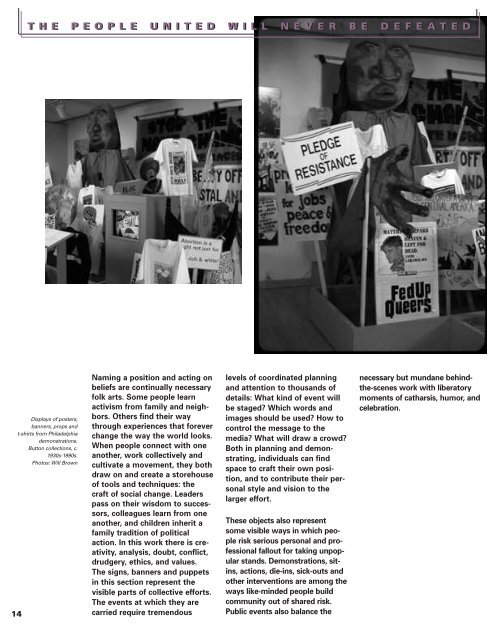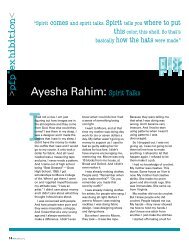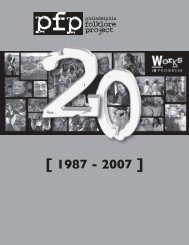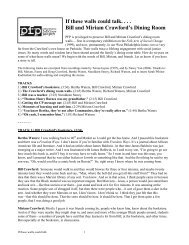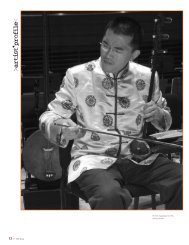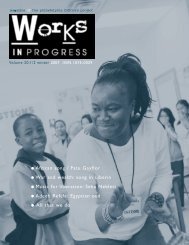View PDF - Philadelphia Folklore Project
View PDF - Philadelphia Folklore Project
View PDF - Philadelphia Folklore Project
Create successful ePaper yourself
Turn your PDF publications into a flip-book with our unique Google optimized e-Paper software.
T H E P E O P L E U N I T E D W I L L N E V E R B E D E F E A T E DF O L K A R T S O F S O C I A L C H A N G E E X H I B I T I O NRecord your chantDisplays of posters,banners, props andt-shirts from <strong>Philadelphia</strong>demonstrations.Button collections, c.1930s-1990s.Photos: Will Brown14Naming a position and acting onbeliefs are continually necessaryfolk arts. Some people learnactivism from family and neighbors.Others find their waythrough experiences that foreverchange the way the world looks.When people connect with oneanother, work collectively andcultivate a movement, they bothdraw on and create a storehouseof tools and techniques: thecraft of social change. Leaderspass on their wisdom to successors,colleagues learn from oneanother, and children inherit afamily tradition of politicalaction. In this work there is creativity,analysis, doubt, conflict,drudgery, ethics, and values.The signs, banners and puppetsin this section represent thevisible parts of collective efforts.The events at which they arecarried require tremendouslevels of coordinated planningand attention to thousands ofdetails: What kind of event willbe staged? Which words andimages should be used? How tocontrol the message to themedia? What will draw a crowd?Both in planning and demonstrating,individuals can findspace to craft their own position,and to contribute their personalstyle and vision to thelarger effort.These objects also representsome visible ways in which peoplerisk serious personal and professionalfallout for taking unpopularstands. Demonstrations, sitins,actions, die-ins, sick-outs andother interventions are among theways like-minded people buildcommunity out of shared risk.Public events also balance thenecessary but mundane behindthe-sceneswork with liberatorymoments of catharsis, humor, andcelebration.Chants are memorable, portable, and effective verbal art forms that can unify acrowd. People recall not only the words of chants but what it felt like to hearothers shouting the same words together… At the exhibition, we invited peopleto write their memories of chants on re-recordable cards. Our chant wall filled upwith words passed on, folk poetry remembered, reused…and people gatheredaround to listen to one anothers’ words.What do we want? Freedom! When do we want it? Now!What do we want? Justice! When do we want it? Now!What do we want? A Union! When do we want it? Now!What do we want? A contract! When do we want it? Now!1, 2, 3, 4. We don’t want your racist war.1, 2, 3, 4. Open up the clinic door. 5, 6, 7, 8. Don’t tell us when to procreate.Stop the bombing, stop the war. U.S. out of El Salvador.Hey, hey, ho, ho! The death penalty has got to go.Hey, hey, ho, ho! Clinic bombers have to go.Hey, hey, LBJ! How many kids did you kill today?Hey, hey, Reagan and Haig! How many nuns did you kill today?Hey, hey, what do you say? How many workers have you screwed today?Racist, sexist, anti-gay. Born-again bigots go away.Hell, no, we won’t go! We won’t fight for Texaco!Ronald Reagan, he’s no good! Send him back to Hollywood!Stop anti-abortion lies. We will not be terrorized.Gay, straight, black, white. Same struggle, same fight..The people united will never be defeated.Our bodies, our lives. Our right to decide.Down with dope. Up with hope.Say it loud. I’m black and I’m proud.Ho, Ho, Ho Chi Minh!No justice. No peace.They say give back. We say fight back.Peace! Now!Freedom! Now!Fed Up. Can’t take it anymore.Give me a U-N-I-O-N. What’s that spell?The Unions got the power. Workin’ people’s power.Power, power, power! Power by the hour.Condensed messagesLapel buttons get the word out, display solidarity and help people connecton issues they care about. Wearing a button is about making apublic declaration of a personal belief. The words on a button can sparkconversation and debate, whether between strangers or friends. Theyhelp people of like minds to connect, and they make divisions apparent.A button asks its reader, “Where do you stand?” or “Are you with me oragainst me?” These small beacons help a community survive when it isunderground or virtually invisible in mainstream culture.Buttons’ size and durability make them easy to keep through theyears. People who save their buttons are recording their own history ofpolitical activity and interests; many collections chart their owner’spolitical growth, along with changes in perspective and in intensity ofcommitment. Button collections also provide details about politicalparties and campaigns, networks of organizations, significant eventsand battles, and the leaders and martyrs of political causes. Likebumper stickers and t-shirts, buttons condense a political positioninto a few succinct words.[Continued on p. 16 ➝]15


